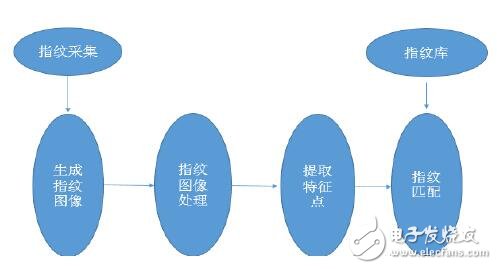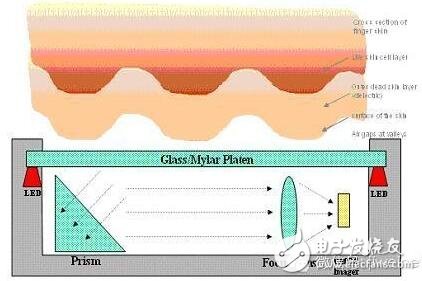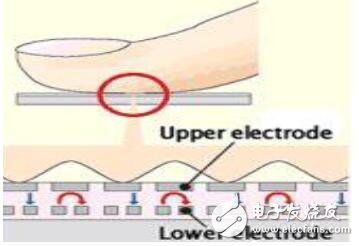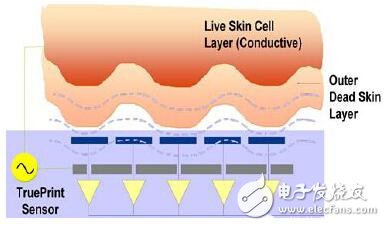With the advent of emerging technologies such as mobile internet and Internet of Things, some traditional methods for identifying and identifying people have failed to meet the needs of social development. Through computer and optical, acoustic, biosensor and biostatistics and other high-tech means, the use of the body's inherent physiological characteristics (such as fingerprints, face, iris, etc.) and behavioral characteristics (such as handwriting, sound, gait, etc.) ) To identify individuals and become the general trend.
At present, the main biometric identification methods include fingerprint recognition, palmprint recognition, iris recognition, facial recognition, DNA recognition, and behavior recognition. At present, fingerprint recognition is more common in various application fields.

In the first half of 2016, domestic fingerprint identification chip shipments reached 156 million, a year-on-year increase of 210%, and market demand grew rapidly. In addition, from the domestic fingerprint identification module market, the penetration rate of fingerprint recognition in smart phones reached 25% in 2015, and the demand for fingerprint identification modules exceeded 100 million. In 2016, the penetration rate of domestic fingerprint recognition in smart phones was 40%. It is expected that the penetration rate of domestic fingerprint recognition in smart phones will reach 75% by 2020, and the demand for domestic fingerprint identification modules will exceed 340 million.
First, the basic principle of fingerprint recognition and acquisition technology
A typical fingerprint identification system should include: fingerprint recognition sensor + feature extraction / matching module + feature template library + application software. The matching of the fingerprint can be divided into two steps. First, the feature of the fingerprint to be verified is extracted, and then the similarity is compared with the template fingerprint in the fingerprint template library to determine whether the two fingerprint images are from the same finger.

We can see that the fingerprint identification core is accurate and efficient in collecting fingerprint analysis. The development of fingerprint recognition acquisition technology can be roughly divided into three ways: optical recognition, capacitive sensor, bio-RF
Optical recognition
Optical recognition is an earlier fingerprint recognition technology. The light emitted by the optical transmitting device is reflected on the finger and then reflected back to the machine to obtain data, and the database is compared to see if it is consistent. Optical recognition can only reach the epidermal layer of the skin, not the dermis layer, and is greatly affected by the cleanness of the finger surface.

Capacitive sensor
Capacitive sensor identification is the use of two capacitors installed at a certain interval. Using the bump of the fingerprint, the current of the two capacitors is turned on or off when the finger slides over the fingerprint detecting instrument to detect the fingerprint data. The capacitive sensor's clean requirements for the finger are still relatively high, and the sensor surface is made of silicon material, which is relatively easy to damage.

Technically, the supply of capacitive fingerprinting technology is Authentec, Validity, FingerPrint Cards AB (FPC), etc. Authentec was bought by Apple and Validity was acquired by SynapTIcs. Capacitive fingerprint sensors are also the most common technology used today.
Biological radio frequency
The RF sensor emits a small amount of RF signal through the sensor, and penetrates the skin layer of the finger to obtain the texture of the inner layer to obtain information. This method requires less cleanliness of the fingers.

Second, fingerprint identification collection method
No matter what acquisition technology is used, there are two types of input methods from the user's point of view: push type and slide type.
Sliding: By swiping your finger across the sensor, the system can get the fingerprint of the entire finger. When the finger is pressed up, the complete image cannot be acquired at one time. During the collection, the finger needs to be swept over the collection surface, and each fingerprint image collected by the finger is snapshotted, and the snapshots are stitched together to form a complete fingerprint image. Sliding sensor, sliding from top to bottom, then complete fingerprint stitching
The advantage of sliding type is low cost, easy integration, large-area image acquisition, and traditional feature point algorithm. However, the disadvantage is that the customer needs to have a consistent standard motion to capture images, and the experience is relatively poor. Too successful.
Push type: The finger is placed flat on the device to obtain a fingerprint image. In general, in order to obtain the fingerprint of the entire finger, it is necessary to use a sensor larger than the finger, and the entire finger is simultaneously pressed on the sensor.
The advantage of the push type is that the customer experience is good, and the image can be collected with only one press, matching the customer's operating habits in the mobile application without educating the customer. The disadvantages are: high cost, difficulty in integration, relatively small image area at one time, and insufficient feature points, which need to be identified by a complex image matching algorithm.
Third, the global mobile phone fingerprint identification program vendor analysis
Faced with such a huge market, Apple took the lead in standardizing fingerprint recognition on the iPhone 5s, which promoted the application of fingerprint recognition technology in the smart phone market. After that, many domestic chip manufacturers also entered the fingerprint identification market, and the number was numerous. At present, foreign fingerprint identification manufacturers mainly include AuthenTec (acquired by Apple in 2012), FPC, SynapTIcs and other international major manufacturers, as well as Taiwanese manufacturers such as Aegis, Elan, Duntai and Maoming. There are more than ten enterprises including Huiding, Mindwei, Fei Engel, Xinyi, Xinqihang, Beite, Si Liwei, Ji Chuang North and BYD.
1, AuthenTec
Founded in 1998, AuthenTec has been the world's largest supplier of inductive fingerprinting sensors, and its fingerprint recognition component has been embedded in Windows notebooks for many years. In 2011, AuthenTec developed a new fingerprint recognition technology based on capacitance and radio frequency identification, called “TruePrintâ€. The patented TruePrint technology can read the active layer under the skin surface (where the human fingerprint is actually located). Extremely accurate and reliable fingerprint imaging.
Prior to being acquired by Apple in 2012, AuthenTec has become the world's leading supplier of fingerprint sensors and chips and modules, identification software and encryption security solutions with annual sales of $70 million and more than 200 patents and 230 patents. The company employs more than 35 million sensors worldwide, including Alcatel-Lucent, Cisco, HP, Samsung, Lenovo, LG, Motorola, Nokia and more.
In July 2012, Apple spent $356 million to acquire AuthenTec, and AuthenTec began to stop selling fingerprint chips to third parties. In 2013, Apple's iPhone5s Touch ID chip was the product of AuthenTec, which was well received by the market and set off a fingerprint identification boom. Subsequently, many of Apple's new products are equipped with AuthenTec fingerprint identification chip.
2, FPC (Fingerprint Cards)
FPC is a Swedish biometric sensor technology company that develops, manufactures and markets fingerprint identification technology and provides two types of fingerprint recognition sensors, touch and wipe. As early as 2013, FPC also began to enter the smartphone market. Thanks to AuthenTec's offering of products and technology to Apple alone, FPC became the leader of the non-Apple mobile phone camp.
The first mobile phone with fingerprint recognition in China, Konka K5, and Pantech's latest 5.5-inch flagship and tablet PC, the third largest mobile phone supplier in Korea, are equipped with FPC scratch-type fingerprint sensors. In October 2013, Fujitsu of Japan released four Android smartphones and two Android tablets with FPC wipe fingerprint recognition sensors. In 2014, Huawei Mate 7 adopted the FPC touch fingerprint recognition sensor. Subsequently, domestic brands such as Xiaomi have begun to adopt FPC touch fingerprint recognition sensors.
FPC's technological competitive advantages include unique image quality, low power consumption and a complete biometric system, but its sensor price is not low. However, with the impact of many domestic fingerprint chip manufacturers (especially Huiding), the price of FPC is also falling.
3, SynapTIcs (new thinking)
Founded in 1986, SynapTIcs is a global leader in the design of electronic design automation (EDA) software tools. Since the acquisition of Validity by synapTIcs in October 2013 for $255 million, Synaptics has been involved in the fingerprinting industry. However, its fingerprint recognition sensor was mainly based on scratch-type (sliding acquisition), and the scratch-type fingerprint recognition sensor on mobile phones such as Samsung Galaxy S5 and HTC One Max was provided by Synaptics. But the scratching experience is still worse than the push-type sensor.
In early 2015, Synaptics also introduced the use of Natural ID fingerprinting technology for high-end mobile devices. At present, Lenovo, ZTE, Gionee, Coolpad, etc. in China also use Synaptics' fingerprint recognition sensor.
On December 12, 2016, Synaptics announced that its third-generation Natural ID glass under-glass fingerprint sensor Natural ID FS4500 has been sampling since September. The biggest feature of the FS4500 is that it can scan fingerprints through glass or ceramic buttons. After mass production, mass production is expected to be realized in the fourth quarter of this year.
On December 13, Synaptics announced the industry's first Natural ID for optical fingerprint sensors for smartphones and tablets? Series biometric solution FS9100. According to reports, the Natural ID FS9100 series of optical fingerprint sensors can achieve high-resolution scanning through a 1mm full cover glass, and a simple, button-free industrial design.
4, Qualcomm
At the 2015 MWC show, Qualcomm released Sense ID 3D ultrasonic fingerprinting technology. Compared to the pressed capacitive sensor, the 2D fingerprint image is captured, and the ultrasonic scan of the Sense ID can penetrate the outer skin of the finger, capturing unique features such as the fingerprint ridge and the sweat pore, thereby identifying the unique 3D feature of the user's fingerprint. This produces a fingerprint surface map that is rich in detail and difficult to copy.
Its biggest feature is that it does not require capacitive sensors or buttons, and can be hidden under a variety of material surfaces, such as glass, plastic and even metal. At the same time, the accuracy of scanning fingerprints is not affected by finger dirt, grease and sweat, which is not possible with Apple Touch ID.
At present, this technology has been used by many professional organizations and government departments. The Xiaomi 5S is equipped with Qualcomm's ultrasonic fingerprint recognition chip. However, Qualcomm's ultrasonic technology currently only supports the Qualcomm Xiaolong 800 series platform.
5, Duntai
As a leading company in the touch industry, Duntai entered the field of fingerprint identification very early, but it really started early, and it was a late episode. On September 24, 2014, Duntai cooperated with Norwegian fingerprint identification factory IDEX (IDEX focused on fingerprint identification technology development, with more than 200 patents, including patent cross-licensing with AuthenTec) to jointly develop slider-type fingerprint sensing. Device, grab the fingerprint identification market. At the end of 2014, Duntai officially released a complete fingerprint identification program. Then the smartphone based on the Duntai FT9200 fingerprint identification solution was officially launched in February 2015, but then Duntai's fingerprint business almost fell into stagnation. At present, the shipment of Duntai fingerprint chips is very small.
The main reason is that most of the backbone of the original fingerprint recognition technology team left. Some people followed Mo Lianghua (Dong Taiyuan, deputy general) to set up Xinyi Technology, and another group set up the core Qihang, both companies are positioned in the field of fingerprint identification.
6, Aegis
Aegis Co., Ltd. (EgisTec) is a leading chip supplier for fingerprint biometrics and data encryption systems in Taiwan, specializing in integrated system solutions designed with a focus on Senser performance and software availability. At the end of 2015, Aegis was listed in Taiwan. Aegis claimed to be the only passive fingerprint identification chip manufacturer in the world. Its products have been adopted by major international companies such as Samsung and domestic mobile phone brands such as ZTE. Aegis products have more than 60 patents in the world. There is no patent trouble in the world.
7. Elan Electronics
Founded in 1994, ELAN is an IC design company based in Taiwan, mainly engaged in research and development and marketing of integrated circuit products. In September 2001, ELAN was listed on the Taiwan centralized market.
Although ELAN Microelectronics began to officially deploy fingerprint recognition chips in 2014, ELAN has long studied fingerprint chips. Elan's first-generation fingerprint recognition chip is a large-size chip with a resolution of 176*176, which is mainly used for credit cards. Subsequently, the fingerprint recognition chip for mobile phones is its second-generation fingerprint identification chip, and in the second half of 2015. Mass production.
In terms of fingerprint chip production, ELAN is mainly handed over to Taiwan UMC and South Korea Magnachip, and the package is in Taiwan. However, due to production problems and fingerprint algorithms, Elan has not progressed as expected this year. The annual shipment will be about 3 million sets, which is lower than the original target of 5 million sets.
8, Huiding Technology
Since its establishment in 2002, Huiding Technology has focused on the field of human-computer interaction chip design. Since it entered the fingerprint identification market in 2013, it has invested a lot of money and manpower in this segment, plus behind MediaTek. Support, the development of Huiding is very fast, and it has made breakthroughs in technological innovation and market. It has become the only series in the industry that can provide coating, cover (glass, sapphire, ceramic), hidden (IFS), and live fingerprint detection. Chip company.
With its technical and cost advantages, Huiding's fingerprint identification products have successfully obtained Huawei, OPPO, vivo, LeTV, ZTE, Xiaomi, Meizu, Lenovo, Gionee, TCL, Amazon, Dell, HP, ASUS, acer, TOSHIBA, Panasonic, etc. Recognized by many well-known terminal manufacturers at home and abroad. Recently, Meizu's new flagship PRO 6 Plus also launched the live fingerprint identification chip of Huiding. Thanks to the adoption of many brand manufacturers, Huiding's fingerprint identification chip shipments have exploded this year.
According to previous analysis of this site, this year's Huiding fingerprint identification chip shipments are expected to exceed 100 million, an increase of 900%. For Huiding, this year will be a year of great harvest.
For the future, Huiding plans to launch its fourth-generation fingerprint recognition chip in 2017, which will support a 210μm thick cover, increasing the Sensor's ratio to 70%, providing lower power consumption and faster unlocking speed. The fifth generation of fingerprint recognition chips will support cover plates up to 700 μm thick. The most eye-catching is its sixth-generation fingerprint recognition chip, which supports In Display's fingerprint recognition technology, that is, fingerprint recognition and touch screen integration, which will bring a new revolution to the fingerprint identification industry. .
9, Bethle
Shenzhen Beitelai Electronic Technology Co., Ltd. was established in July 2011. It is a national high-tech innovative enterprise with high-end integrated circuit design. Focus on consumer electronics IC design in touch, AMOLED driver, fingerprint recognition and life-aware products. At present, it focuses on four products: touch IC, fingerprint recognition, life perception (wearable) and MCU.
In 2013, Beitelai began to develop fingerprint chips. It is an early launch of small face array fingerprint recognition sensors in China. In 2014, it began to ship sliding fingerprint recognition sensors. Subsequently, a pressure fingerprint identification chip was introduced. Since the yield of the cover solution is relatively low, this Betelley chose to push the coating solution.
In addition, Betteley has reached a deep strategic cooperation with Precise Biometrics (PB), a world-renowned fingerprint recognition algorithm manufacturer, to provide fast, accurate and secure user identity authentication.
According to reports, Beitlay's fingerprint chip adopts 0.18um digital-analog mixing process, in addition to being able to quickly unlock the screen, ultra-low power consumption, dry and wet finger adaptation, it also has a small area, simple process requirements, and relatively low cost. Low characteristics. In addition, Bethel fingerprint sensors integrate a variety of technologies, such as True-Print radio frequency identification technology, pixel self-correction technology. Through these new technologies, Bethle claims to achieve a finger recognition rate of up to 99.9%, eliminating fake fingers.
10, Si Liwei
Founded in January 2011, Shanghai Sili Microelectronics Technology Co., Ltd. is mainly engaged in the research and development of multi-touch sensors, fingerprint sensors, integrated circuit chips and products and related electronic components. As early as May 2014, Sili Micro launched the first push-type fingerprint recognition sensor GSL6162 and its integrated solution.
At present, Sili Wei already has a coating fingerprint identification scheme and a ceramic/glass/sapphire cover fingerprint identification scheme, but the main push is the coating fingerprint identification scheme on the back.
Thanks to the original accumulation of Sili Wei in the field of touch and the influence of its parent company Gege Micro in the field of cameras, many fingerprint module manufacturers have cooperated with Sili Micro (including Kyle Optoelectronics, Win-Win Xing, Helitai, Xinli, Sangle, Huatian Technology, Jinlong Electronics, Saihua, Shengtai Imaging, Kaimujin, Xinhongbo and other module manufacturers with more shipments).
However, due to the lack of advantages in terms of product performance and cost (there is no support for metal-free rings), and some of the customer maintenance and technical support can not keep up, the overall shipment is not much.
Mono LCD is a cutting-edge technology that delivers crystal-clear images with high contrast and sharpness. Our Mono LCD displays feature advanced technology that enhances the visual experience, making it ideal for gaming, designing, and professional use. With our Mono LCD screens, you can expect accurate color reproduction, excellent viewing angles, and fast response times. Our displays are designed to provide the best possible visual experience, making them the ultimate choice for anyone who demands the best. Whether you're a gamer, designer, or professional, Mono LCD displays are the perfect choice for enhancing your visual experience.
Mono LCD Displays,Mono LCD Screens,Mono LCD Monitors,Mono LCD Modules,Mono LCD Panels
ESEN Optoelectronics Technology Co., Ltd, , https://www.esenlcd.com